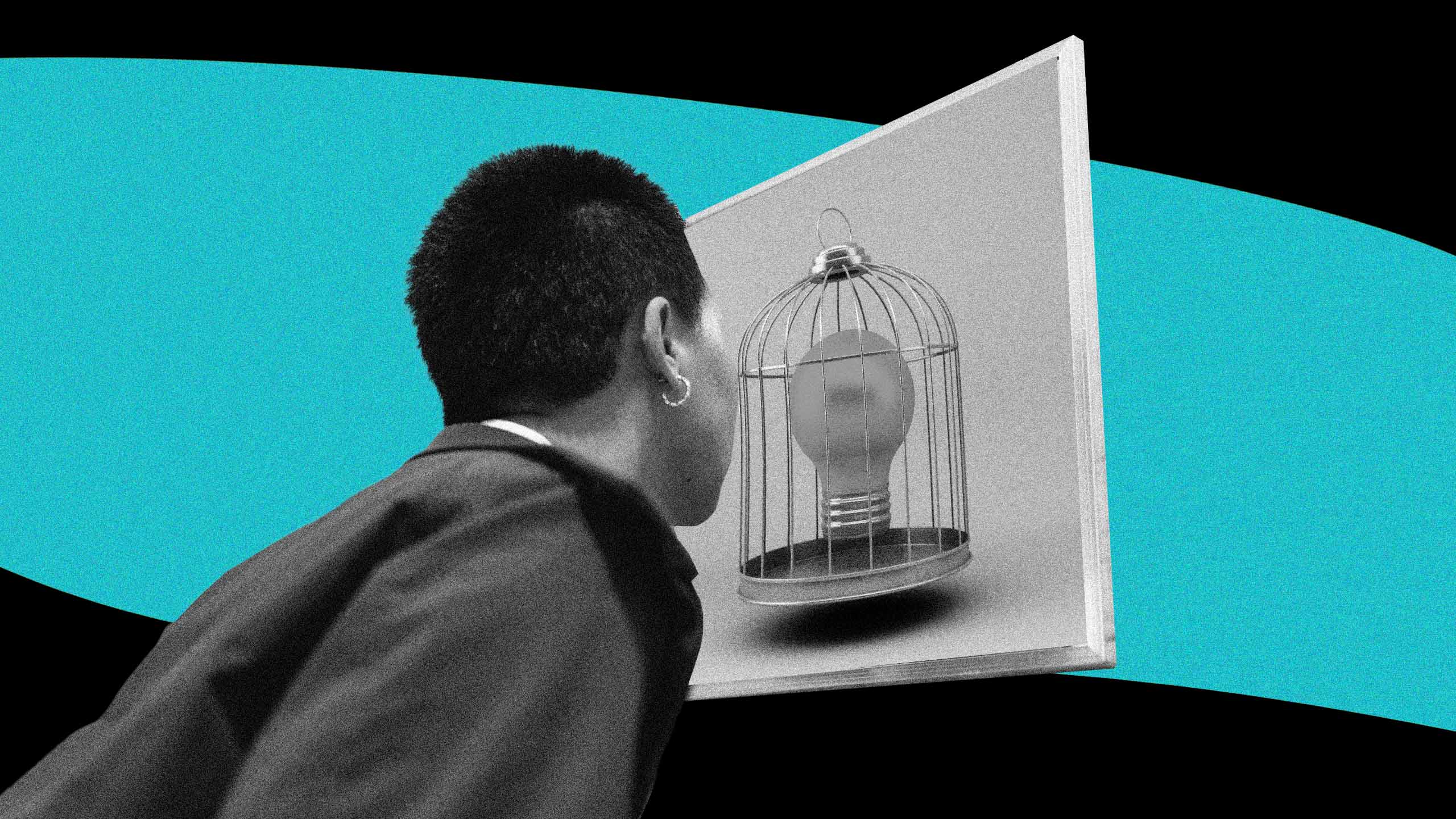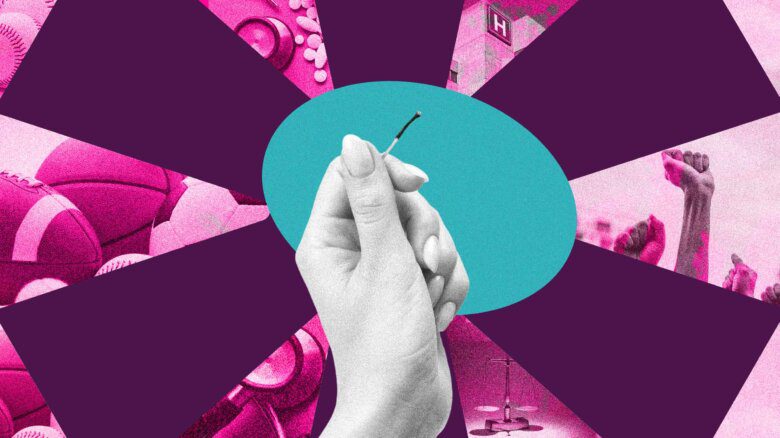Over the past year, the term “gender ideology” has increasingly seeped into Canada’s political lexicon. At a meet-and-greet in November, Conservative leader Pierre Poilievre accused Prime Minister Justin Trudeau of attempting “to impose his radical gender ideology” on children and schools. The 1 Million March 4 Children, a movement that brought about demonstrations across Canada last fall, has similarly invoked this rhetoric, calling for the elimination of sexual orientation and gender identity (SOGI) educational resources, as well as “pronouns, gender ideology and mixed bathrooms in schools,” according to the organization’s website.
What does “gender ideology” really mean? And what does it reveal about the motivations, rhetoric and future of what’s called the “anti-gender movement,” a coalition of groups that oppose SOGI rights, feminism, access to abortion and marriage equality? Xtra asked three experts about “gender ideology” and its connections to the global campaign against LGBTQ2S+ rights.
What is “gender ideology”?
“Gender ideology” is a term used by anti-LGBTQ2S+ groups to refer to a set of fabricated beliefs about queer and trans rights, women’s rights and reproductive rights. The concept has been invoked by right-wing groups across the world to advance anti-trans narratives, such as the notion that inclusive gender and sexuality education violates parents’ rights and the myth that trans women threaten the safety of women’s spaces.
Experts who analyze the anti-LGBTQ2S+ movement have emphasized the purposeful broadness of the term “gender ideology,” often describing it as an “empty signifier” or a “symbolic vessel.” “It means a lot and not very much,” says Claire House, a B.C.-based researcher who maps the anti-gender movement and has worked with advocacy organizations including Egale, Plan International and the U.K. charity Stonewall. “It’s an idea that you can fill with all kinds of different things to deploy politically in different settings.”
Emerson Hodges, a research analyst at the Alabama-based Southern Poverty Law Center (SPLC), says that capacity to unify different groups and causes makes “gender ideology” a particularly potent concept.“The broadness of it allows the right to really manipulate the narrative about the core societal beliefs of conservatism, traditionalism and the religious right,” he says. According to a March 2023 landscape analysis from Transgender Europe (TGEU), an organization consisting of over 200 groups across Europe and Central Asia, anti-LGBTQ2S+ activists have employed the frame of “gender ideology” as a catch-all for ideas that challenge cisheteropatriarchy. In countries such as Poland, politicians have used this rhetoric to target not only trans rights, but other gender-based issues such as abortion and marriage equality.
Where did the term come from?
Researchers often trace the language of “gender ideology” back to the mid-1990s, to the Vatican’s campaign against the use of the word “gender” at the United Nations (UN). The Holy See, the government of the Catholic Church, serves as a permanent observer to the UN, meaning it can take part in meetings and discussions. That gives it the power to oppose the use of inclusive language in human rights documents, as it has done with the category of “gender.”
Arguably, however, the use of “gender ideology” stretches back even further. Hodges, who works on the SPLC’s Intelligence Project, an initiative that tracks extremist groups across the U.S., says the history of the concept can’t be detached from terms such as the “gay agenda,” which has long been used by the American religious right to suggest that queer people are trying to undermine family values. In the ’70s, anti-LGBTQ2S+ activists such as Anita Bryant advanced the myth that because gays and lesbians can’t reproduce, they “recruit” children. Today, conservative narratives about queer and trans people “indoctrinating” and “grooming” kids adopt a similar frame. “When gender ideology is invoked now, it’s a callback to those things,” says Hodges.
Christian institutions and groups aren’t the only ones pushing this rhetoric. House says that around 2016, the Vatican’s weaponization of gender began to gain traction in the Anglophone world. At the same time, trans rights became a target in the U.S. Conservative and evangelical groups with ties to the Republican Party and Trump’s “Make America Great Again” movement realized that rhetoric around “gender ideology” could be used to advance the notions that “wokeness” has gone too far, that liberals are taking over schools and society and that freedom of speech is increasingly under threat.
Alarmingly, growing anti-trans hate seems to reflect the global breakdown of democratic institutions and values such as freedom of speech.“The anti-gender movement is one aspect of this broader anti-rights trend that we see around the world,” says Deekshitha Ganesan, a policy officer who works to combat the anti-trans movement at TGEU. “We do have a bigger challenge confronting us.”
Why is the term so dangerous?
Similar to concepts such as “the SOGI agenda” and “critical race theory,” the flexibility of the term “gender ideology” allows anti-LGBTQ2S+ groups to package ideas about a broad selection of gender-based rights and then frame them as a threat to social institutions such as the family and the nation. Hodges says “gender ideology” casts the push for queer and trans rights as a conspiracy: a coordinated effort to spark social upheaval and transform society for the worse.
The term also lends anti-trans actors a facade of objectivity. “They’re essentially trying to intellectualize transphobia,” says Hodges. By invoking pseudoscientific language, rhetoric about “gender ideology” turns LGBTQ2S+ identities into a debate. “The main goal of LGBTQ2S+ acceptance and progress is the right to exist,” says Hodges. “This term has been used to invalidate that and demonize that existence without outwardly saying that.”
What groups are using this term, and why?
Anti-trans groups with diverse goals have rallied under the banner of rejecting “gender ideology” to form unholy alliances, says Ganesan. According to TGEU’s March 2023 report, there are two key narratives that fuel these anti-gender actors’ arguments: a conservative understanding of family, gender and sexuality, as well as the notion that trans rights threaten the rights of women and other marginalized groups.
For religious and conservative bodies, the fight against “gender ideology” is about maintaining the dominance of the nuclear family and the gendered division of labour, explains Ganesan. TGEU’s report outlines how these groups often claim that they are defending traditional values and protecting children from danger while advancing anti-trans arguments. In order to cement gender roles, these evangelical and other religious groups fund and fuel moral panic around the very notion of gender and LGBTQ2S+ rights. A 2021 report from the European Parliamentary Forum for Sexual and Reproductive Rights found that from 2009 to 2018, fifty-four anti-gender organizations spent USD $707.2 million on funding the movement in Europe. These groups were primarily located in the U.S., Russia and the rest of Europe, and included non-governmental organizations, foundations, religious groups and political parties.
Anti-trans religious and right-wing groups also often invoke the language of “gender ideology” alongside nationalist and xenophobic sentiments, framing gender as an idea imposed by forces outside of Christian and conservative societies. “It manages to make it seem like these notions of gender or sexual orientation are all concepts that are alien to many cultures,” says Ganesan. This myth erases the long existence of gender and sexual diversity in societies across the world, feeding on fears about foreign influence and effectively othering LGBTQ2S+ people.
For instance, in 2020, the Hungarian government passed legislation to ban trans and intersex citizens from legally changing their gender. According to TGEU’s March 2023 report, the incumbent right-wing party Fidesz “framed their actions as countering the notion of ‘gender ideology’ as ‘Western lifestyle values.’” Similar nationalist anti-LGBTQ2S+ narratives have emerged in countries such as Turkey, whose president conjured the image of “a strong nation” while stating that his party is “against the LGBT” at a campaign rally last year.
Meanwhile, groups that are sometimes seen as more aligned with leftist causes have also adopted “gender ideology” rhetoric to target trans people. Trans-exclusionary feminists and queer activists who advocate for “dropping the T” from the LGBTQ2S+ acronym often suggest that trans rights come at the cost of women’s safety and the rights of other members of the queer community. While they claim to stand for feminism or the rights of gay, lesbian and bisexual people, these groups push transphobic ideas and operate on flawed, binaristic understandings of sex and gender.
How is the term showing up in Canada?
According to House, similar camps unite under the anti-gender movement in Canada. As in many European countries, trans-exclusionary feminists and LGB groups as well as traditional conservative organizations with links to the Christian right and histories of national anti-LGBTQ2S+ lobbying are part of the discourse. These groups have worked together in Canada and the U.S. to promote anti-trans legislation. Far-right extremists and right-wing populist parties have also joined the Canadian movement at different points, employing the rhetoric of “gender ideology” to push their own agendas. The 2022 Freedom Convoy is one example: as governments dropped COVID-19 public health measures, many protestors shifted their focus to campaigning against LGBTQ2S+ rights, capitalizing on that language as a vehicle for their broader conservative beliefs.
While these anti-LGBTQ2S+ groups are coordinated and have similar motivations, House says they aren’t centralized. “Sometimes, what we fall into even on the progressive side is conspiratorial thinking,” they say. There are well-funded right-wing foundations working to promote conservative world views, but they don’t dictate the actions of every anti-LGBTQ2S+ activist and group. Instead, strategies and ideological frames travel across countries and movements in a much more complex way, with think tanks and activists spreading disinformation online and learning from each other.
Canada is particularly influenced by American political discourse. “Sometimes it doesn’t feel like we’re dealing with a Canadian set of movements,” says House. “It feels like we’re dealing with Canada as the 51st state of the U.S.” Domestic hate groups have picked up on campaigns such as the “grooming” narrative pushed by American politicians and anti-trans activists after Florida’s implementation of the “Don’t Say Gay” law in 2022. Anti-LGBTQ2S+ narratives originating from the U.S. have also flowed into Europe and Latin America, pointing to the ease with which false information travels across borders and between anti-gender groups.
What does the growing use of the term in Canadian and U.S. political spaces mean for LGBTQ2S+ rights?
In Canada, over the past year, conservative politicians have increasingly begun to introduce anti-LGBTQ2S+ policies and to use ideas such as “gender ideology” and “parental rights” to pander to voters. Last fall, the Conservative Party approved a transphobic “bathroom bill” and a policy to end gender-affirming care for youth at its annual convention. While Poilievre isn’t obligated to adopt the proposals in his party platform, LGBTQ2S+ leaders have called out the policies as dog whistles that target trans people. Earlier in 2023, Saskatchewan and New Brunswick introduced policies to mandate parental consent when students under 16 want to use a different name or pronouns at school. For years before that, People’s Party of Canada leader Maxime Bernier had been rallying against “gender ideology” and trans rights.
House says that the mainstreaming of “gender ideology” rhetoric may bring more anti-LGBTQ2S+ policies and mark a shift in Canada’s political culture, as has happened in areas such as the U.K., France, Spain and Latin America. “We might begin to see conservative or right-wing populist parties begin to use gender as a way of demarcating different electoral audiences that they want to appeal to,” they say. Conservative politicians and movements in many countries have seized upon trans rights as a wedge issue, using it to boost support and to reach segments of voters across party lines.
The language of “gender ideology” is gaining political traction in the U.S. too. Over the past few years, Florida governor Ron DeSantis has invoked the term to justify bans on SOGI education in schools. Last year, a group of 25 other Republican governors mentioned “gender ideology” in a joint comment opposing proposed federal rule changes to Title IX. (Those changes would expand protections and potentially stop states from introducing anti-trans sports bans for student athletes.) “It is a very common tactic to whip up hysteria around trans and non-binary acceptance,” says Hodges. With a U.S. election scheduled for the fall, there will likely be even more use of “gender ideology” rhetoric to draw support from conservative and Christian voters. “It’s very clear that this term is not going to go away any time soon,” says Hodges.
But relying on anti-trans attacks doesn’t always produce the victories that politicians hope for. Most school board candidates who ran on anti-trans platforms failed to secure seats in Ontario’s and B.C.’s 2022 municipal elections. In the U.S., many conservative school board candidates who campaigned on anti-LGBTQ2S+ points were similarly defeated last November. In January, DeSantis dropped out of the Republican presidential primary race, failing to win over the electorate with his “war on woke” crusade. These blows haven’t erased the anti-gender movement’s presence in the political arena, but they show how anti-LGBTQ2S+ messaging can backfire.
How else can we push back against this rhetoric?
In many ways, increasing conservative opposition to queer and trans rights can be connected to concerns about real social issues, such as poverty and the state’s failure to support people’s livelihoods. The March 2023 TGEU report examines how some anti-gender actors are driven by the sense that they’ve been neglected by the neo-liberal structures that the West has foisted upon their societies. Frustrated by the socio-economic problems brought on by neo-liberalism, these groups engage with the anti-LGBTQ2S+ movement as a way “to find alternatives to ‘the current crises of the liberal democracy’ which fails to meet people’s needs and rights.” This frame is often paired with narratives that position Western elites as colonizers, “gender ideology” as a concept that’s been thrust upon poor people and everyday citizens and religious communities as groups that are in need of protection.
House says progressive politicians and movements need to consider how they can better address gaps in their platforms, rather than allowing conservative groups to exploit these weaknesses to garner votes. “The more that we’re not talking about [issues such as poverty and how it affects different communities], the more that right-wing populist actors can seize on those issues and cultivate these geographies and communities of discontent,” they say.
The rise in anti-LGBTQ2S+ organizing also can’t be detached from the fact that trans people have gained greater visibility over the past decade or so. The 2021 census found that about one in 300 Canadians aged 15 or older are trans or non-binary. In the U.S., fewer than one in three adults personally know someone who is trans, according to 2022 polling data released by The Trevor Project.
Hodges says that amid the entrance of trans identities into the public consciousness, anti-gender groups have exploited people’s lack of understanding and connection to LGBTQ2S+ issues, scapegoating trans people for political motives. “Given the fact that a lot of people didn’t and still don’t know a lot about trans, gender non-conforming and non-binary individuals, it’s easy to create a boogeyman,” he says.
Combating the narrative of “gender ideology” requires that public officials and voters critically analyze the information they’re presented with. Also, media outlets can do a better job of spotting misleading information, debunking anti-trans myths and providing context and history to stem the spread of pseudo-science. House adds that queer and trans advocacy groups and communities can organize opposition against candidates who employ “gender ideology” rhetoric, showing politicians that promoting anti-LGBTQ2S+ ideas isn’t an effective electoral strategy.
Ganesan and House say LGBTQ2S+ organizations need to focus on strategically shifting the narrative and reaching people who are still undecided on their stance toward queer and trans issues. While conservative campaigners have been able to etch ideas of trans people as groomers and predators into the public imagination, LGBTQ2S+ groups sometimes struggle to educate people who lack familiarity with queer and trans issues. “We have these symbolic images that are circulated in politics, and they stick in people’s minds,” says House. “As campaigners, we have to be a bit more savvy and a bit more coordinated about the messages that we’re putting out there.”
Since many of the groups advancing the notion of “gender ideology” also campaign against issues such as reproductive rights, racial justice and climate action, House says there are opportunities for movements to work together. Collaborating to combat anti-LGBTQ2S+ hate can challenge the divisions that the anti-gender movement seek to sow in communities, while conveying a different, more powerful tone than that struck by anti-trans groups.
“If you look at the emotional tenor of how these movements communicate and mobilize, they seize on people’s fears and anger,” says House. “What it does do is leave the space open for more positive messaging—for hope, optimism, defiance, collaboration, positivity, learning, openness and coming together.”


 Why you can trust Xtra
Why you can trust Xtra


